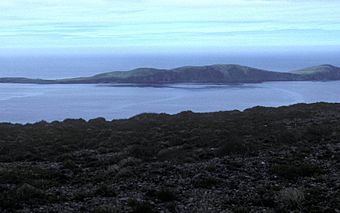Anangula Archeological District facts for kids
|
Anangula Site
|
|
 |
|
| Location | near Umnak Island, Aleutian Islands, Alaska, United States |
|---|---|
| Nearest city | Nikolski, Alaska |
| Area | 47 acres (19 ha) |
| NRHP reference No. | 78000512 |
Quick facts for kids Significant dates |
|
| Added to NRHP | March 24, 1972 |
| Designated NHLD | June 2, 1978 |
The Anangula Site is a very old archaeological site in Alaska. It is also known as the Anangula Archeological District. This special place is found on a small island near Umnak Island in the Aleutian Islands.
The site is about 3.1 miles (5 km) north of Nikolski Bay. It shows us one of the earliest known human settlements in the Aleutian Islands. People lived here around 6400 BCE, which is a very long time ago!
Contents
What is the Anangula Site?
The Anangula Site is important because it helps us understand early human history. Scientists believe it was once part of the Bering land bridge. This was a large land area that connected Asia and North America. Many scientists think the first people came to the Americas by crossing this land bridge.
When people lived at Anangula, the sea level was much lower. It was about 330 feet (100 meters) lower than today. The area was a flat plain with lots of rich waters. This meant there was plenty of food and wildlife for people to hunt.
Why did people leave?
The area around Anangula had many volcanic eruptions. Scientists think that ash from these volcanoes might have made people leave the site. They likely moved to other parts of Beringia to find new homes.
Discovering Anangula
The Anangula site was first found by a scientist named William S. Laughlin in 1938. He was exploring the area and saw signs that people might have lived there.
Later Research
More research was done in the 1950s. But it wasn't until the late 1960s that its true age was understood. Scientists found major parts of the site buried under 6.5 feet (2 meters) of volcanic ash.
What was found?
During the excavations in the 1960s, scientists uncovered parts of eight old houses. They also found more than 30,000 artifacts! These are objects made by humans, like tools or pottery. Some of these artifacts were very different from other things found in North America at that time.
The houses were partly built underground. They were about 10 feet (3 meters) wide and 18 feet (5.5 meters) long. It seems each house was made for a single family.
A Special Historic Place
The Anangula Site is recognized as a very important historical place.
- In 1972, it was added to the National Register of Historic Places. It was called the Ananiuliak Island Archeological District then.
- In 1978, it was named a National Historic Landmark District. This means it's one of the most important historic places in the United States.
Etymology
The island where the Anangula Site is located has had many names over time. These names come from different spellings and pronunciations of its original Aleut name.
Some of the names it has been called include:
- Anangouliak Island
- Ananiuliak Island
- Ananulyak
- Anayulyakh Island
- Ostgraov Anayulyakh


